Samsung 960 Pro 2TiB Review - An aging flagship
A review of the 2048GB Samsung 960 Pro M.2 PCIe NVMe SSD Using Testbed v1.0 and Methodology v1.0.
Mar 16, 2021
- Benjamin Wachman
Tags:
#Methodology-v1
#Testbed-v1
#SSD
#NVMe
#MLC
Released in the second half of 2016, the Samsung 960 Pro was Samsung’s 2nd Generation high-end retail NVMe SSD. It followed in the footsteps of the 950 Pro and OEM-only XP941 as the fastest drives which consumers could get their hands on during the infancy of consumer PCIe SSDs.
The 960 Pro improved upon the 950 Pro by upgrading the previous UBX controller with a new controller called Polaris – not to be confused with the codename of the AMD RX 400-series GPUs released the same year. This started a trend that persists to this day where Samsung gives a consumer friendly name to their SSD controllers rather than just a 3-character designation. Additionally, the 960 Pro series upgrades the 3D V-NAND from 32-layer 128Gb MLC to 48-layer 256Gb MLC.
Although the 960 series hasn’t been the latest and greatest for a number of years it represents the only truly high-end SSD I currently possess. When I purchased it in early 2017, it was one of the only consumer SSDs, M.2 or otherwise, that reached the 2TB capacity I needed, and I paid full retail price for it – $1300. This was the first NVMe drive I’d ever purchased as, at the time, SATA drives were considerably less expensive in terms of $/GB and in most cases I needed capacity over absolute speed. For this reason I was both thrilled yet disappointed when I started using the drive. For a few scenarios it was drastically faster than the SATA drive it replaced, but in many others the improvements underwhelmed.
My biggest letdown with the drive was actually its on-disk copy performance. At the time I wasn’t very familiar with what to expect of PCIe/NVMe SSDs and was expecting that because read speeds were in excess of 3GB/s and write speeds were right around 2GB/s that copy performance would be in the 1GB/s or higher range. This didn’t end up being the case. So while on-disk copies were significantly faster than on SATA drives, they weren’t what I’d been hoping for.
It was this varied real-world performance that made me really excited to put this drive on my testbed and run some measurements on it to see how it fared against other NVMe drives.
Before I get too far, if you want to know more about how I perform the tests in this review, check out my first blog post: SSD Review Background, Setup, and Methodology v1.0. My first round of reviews will all use the same Testbed and Methodology, so will be directly comparable.
The Drive:
Samsung 960 Pro 2048GB
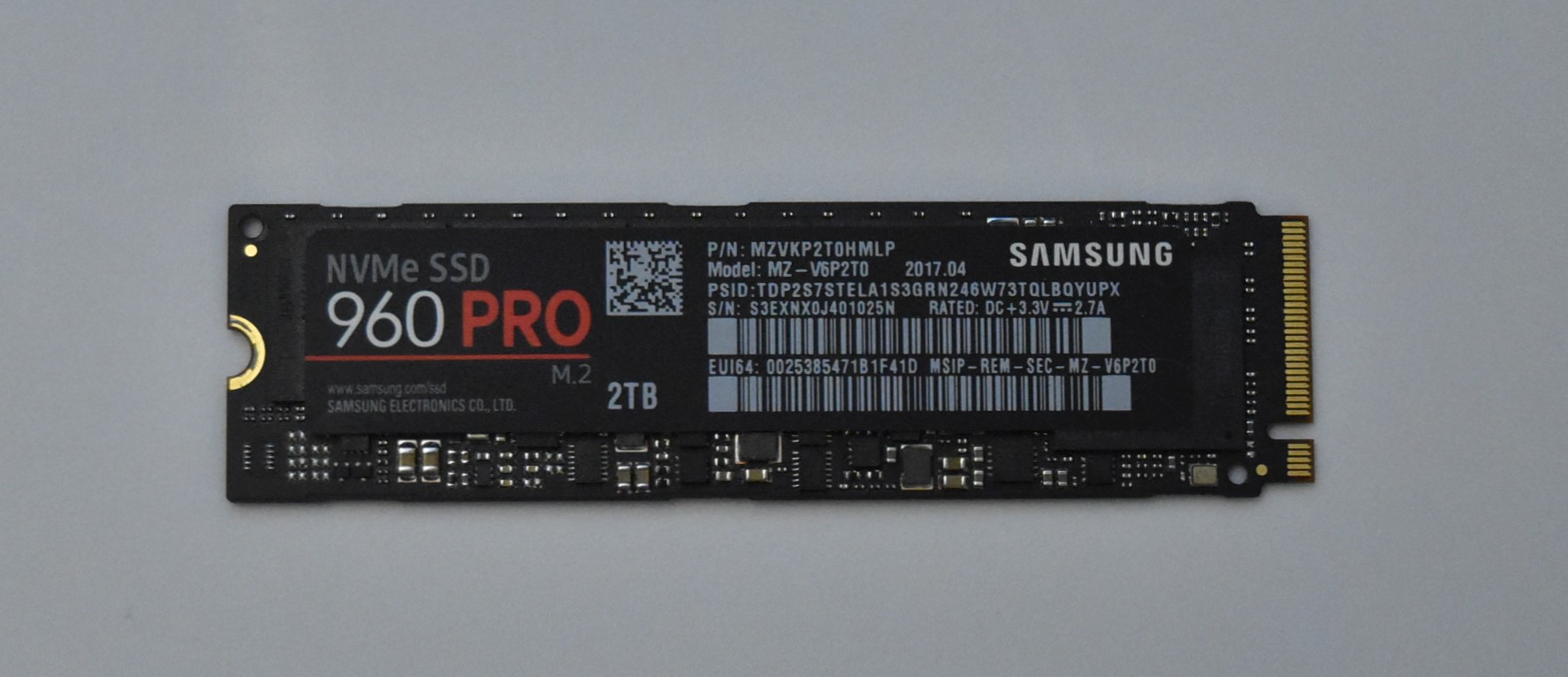 Samsung uses their in-house Polaris controller paired with a full 2GB DRAM cache and 2TiB of 3D V-NAND all mounted to a sylish black PCB.
Samsung uses their in-house Polaris controller paired with a full 2GB DRAM cache and 2TiB of 3D V-NAND all mounted to a sylish black PCB.
| The Drive - Table of Specifications | |
|---|---|
| Samsung 960 Pro | |
| M.2 Dimensions | 2280 |
| Capacity | 2048GB |
| Interface | PCIe 3.0 x4 |
| NVMe Protocol | 1.2 |
| Seq Read | 3500 MB/s |
| Seq Write | 2100 MB/s |
| I/O Read | 440K (4KB @ QD32 with 4T) |
| I/O Write | 360K (4KB @ QD32 with 4T) |
| Active Power | 5.8W |
| Idle Power | 40mW |
| DevSleep Idle | 8mW (L1.2) |
| Components | Samsung Phoenix Controller + 2GB DRAM Cache + 4 NAND Packages |
| NAND | Samsung 48-layer 256Gb 3D V-NAND MLC |
| Rated Endurance | 1200TBW |
| Retail/OEM Drive | Retail |
| Cost New | $1299 |
| Cost Today | ~$450 on eBay |
The 3500MB/s sequential read speed was already running into the limits of the PCIe 3.0 x4 interface, but the peak 2100MB/s still had room to grow in subsequent generations.
Review
For this review I’ll be comparing the 2TiB Samsung 960 Pro to the 1TiB Toshiba XG6, 1TB WD SN550, and 1TB Samsung 860 EVO. The XG6 represents a relatively high performance PCIe 3.0 NVMe SSD, the SN550 represents a several year newer but more mainstream competitor, and the 860 EVO represents high performance SATA SSDs. I’m ommitting the lower end NVMe drives for this review, but if you’d like to compare the results to other drives I’ve tested, the numbers in this review are directly comparable to any of my other reviews with the “Methodology-v1” and “Testbed-v1” tags.
In case you didn’t catch my note at the top, if you’d like to know more about my hardware setup as well as my testing methodology, check out my SSD Review Background, Setup, and Methodology v1.0 piece.
Write Test — Disk Fill Summary
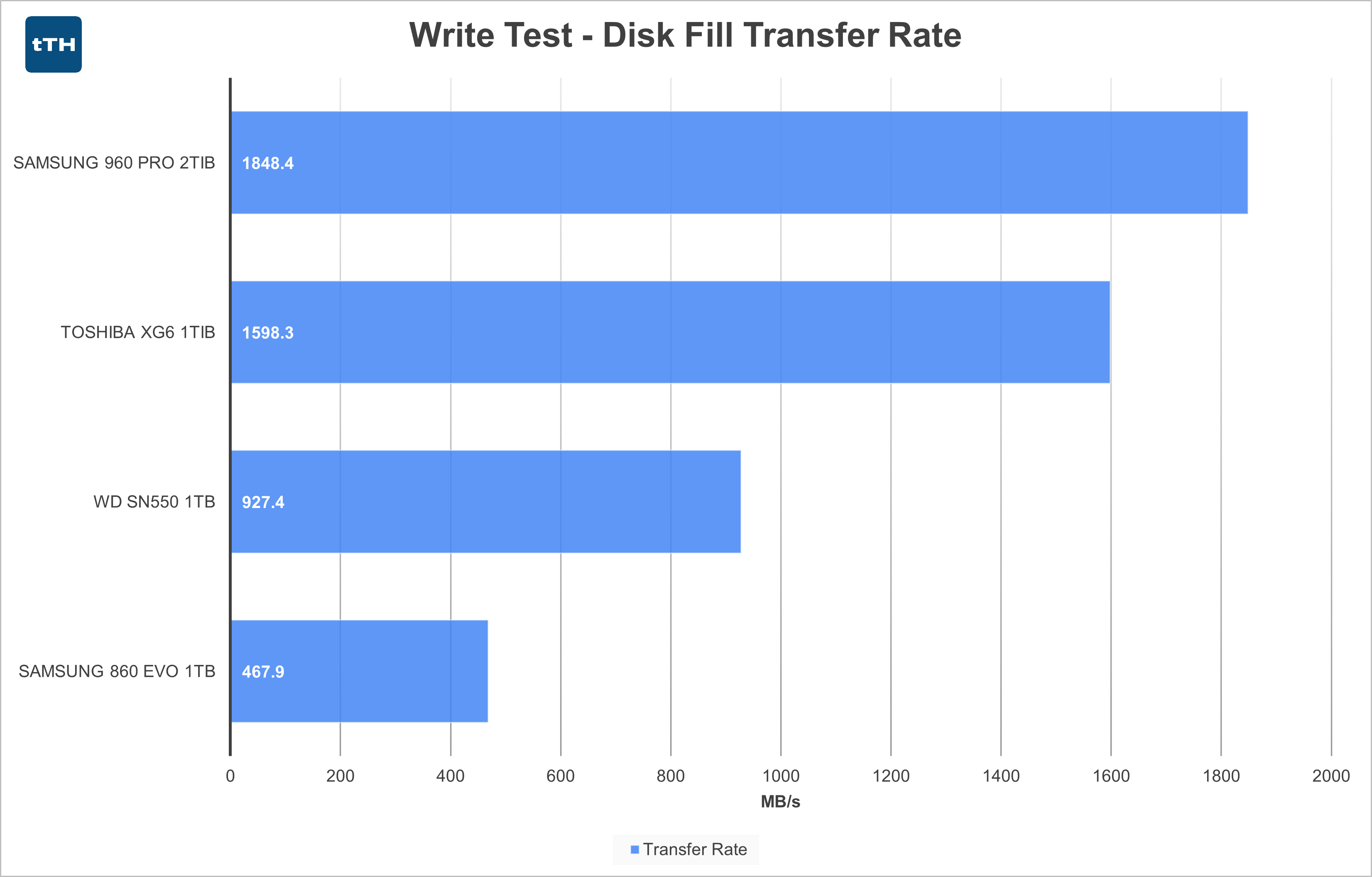
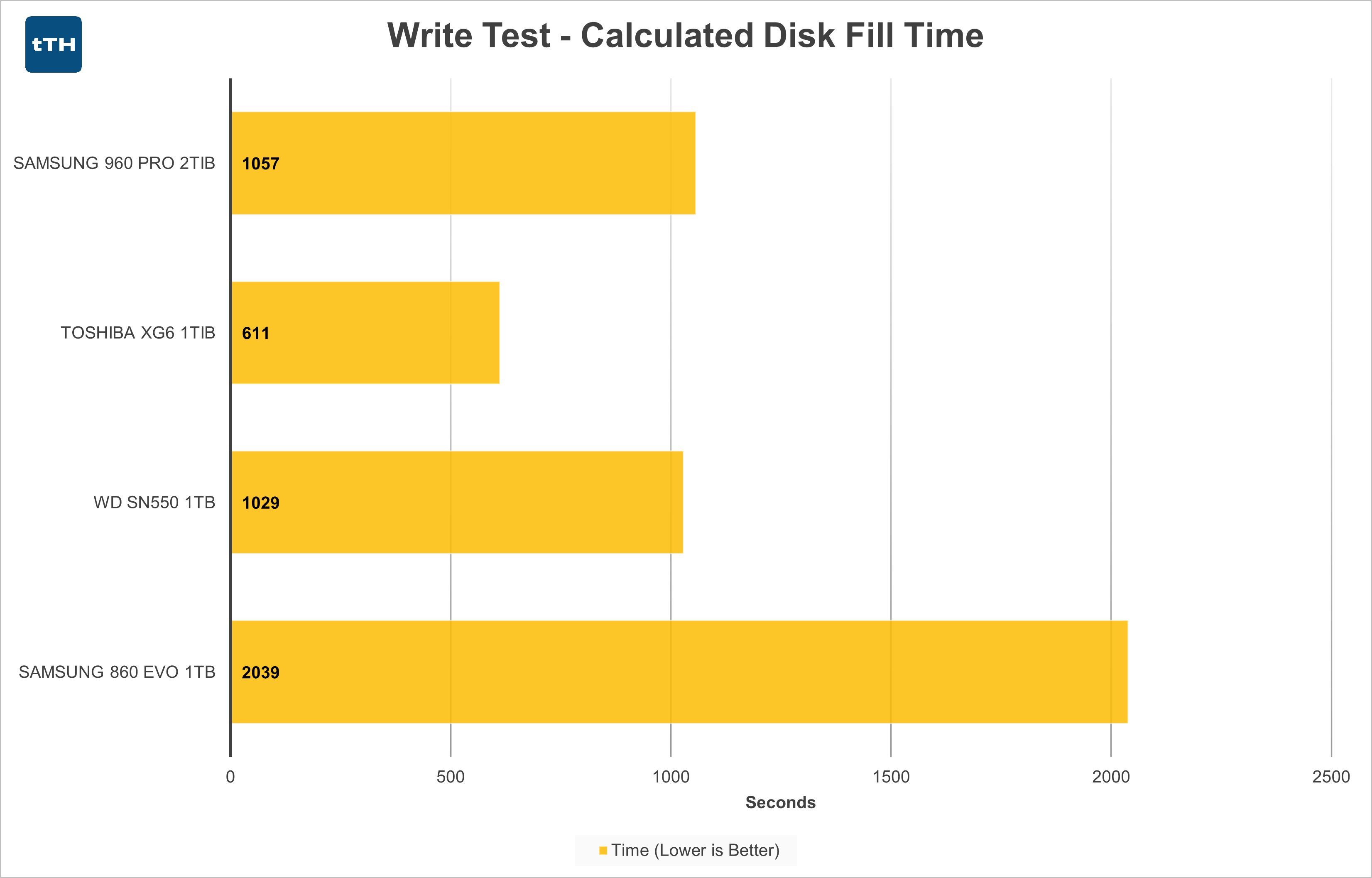 The 960 Pro’s write performance leads this pack of drives by a healthy margin, measuring 1848MB/s average over the whole drive. This is about twice what the entry-level NVMe SN550 delivers and nearly 4x what the SATA 860 EVO musters.
The 960 Pro’s write performance leads this pack of drives by a healthy margin, measuring 1848MB/s average over the whole drive. This is about twice what the entry-level NVMe SN550 delivers and nearly 4x what the SATA 860 EVO musters.
These write speeds translate into quite impressive disk-fill times when considering the 2TiB capacity of the drive. It takes nearly the same amount of time to fill the SN550 and almost double to fill the 860 EVO, despite both drives having half the capacity of the 960 Pro. If you’ve got lots of large data files to move, the 960 Pro is a great contender.
Write Test — Disk Fill
Samsung 960 Pro 2048GB
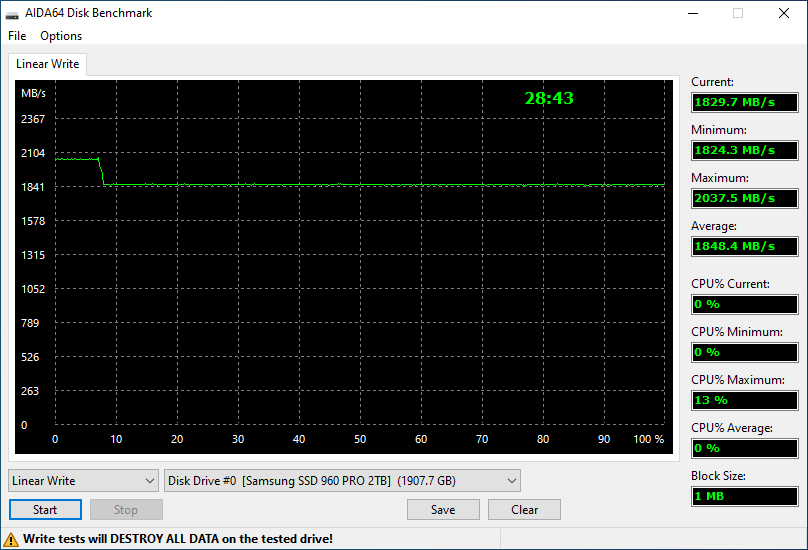 The 960 Pro’s write performance peaks at just over 2000MB/s. This matches the specs provided by Samsung within a reasonable margin of error so it isn’t a disappointment in that regard, but in 2021 this isn’t all that impressive for peak write performance. PCIe 3.0 drives have been shown to deliver more than 50% better peak write speeds and PCIe 4.0 drives extend that lead to more than double.
The 960 Pro’s write performance peaks at just over 2000MB/s. This matches the specs provided by Samsung within a reasonable margin of error so it isn’t a disappointment in that regard, but in 2021 this isn’t all that impressive for peak write performance. PCIe 3.0 drives have been shown to deliver more than 50% better peak write speeds and PCIe 4.0 drives extend that lead to more than double.
That said, due in part to using MLC NAND instead of TLC NAND, the 960 Pro’s sustained write performance only takes a small hit compared to its peak performance, delivering a very steady 1840MB/s from around 7% full all the way to 100% full. Modern drives don’t manage to keep up once their SLC caches are exhausted. One notable exception would be the 970 Pro (also an MLC-based drive) which looks to sustain in the neighborhood of 2800MB/s based on other reviews around the web, but other PCIe 3.0 and even PCIe 4.0 drives seem to regress to below 2000MB/s for sustained writes once their SLC caches are filled.
AS-SSD Sequential Tests
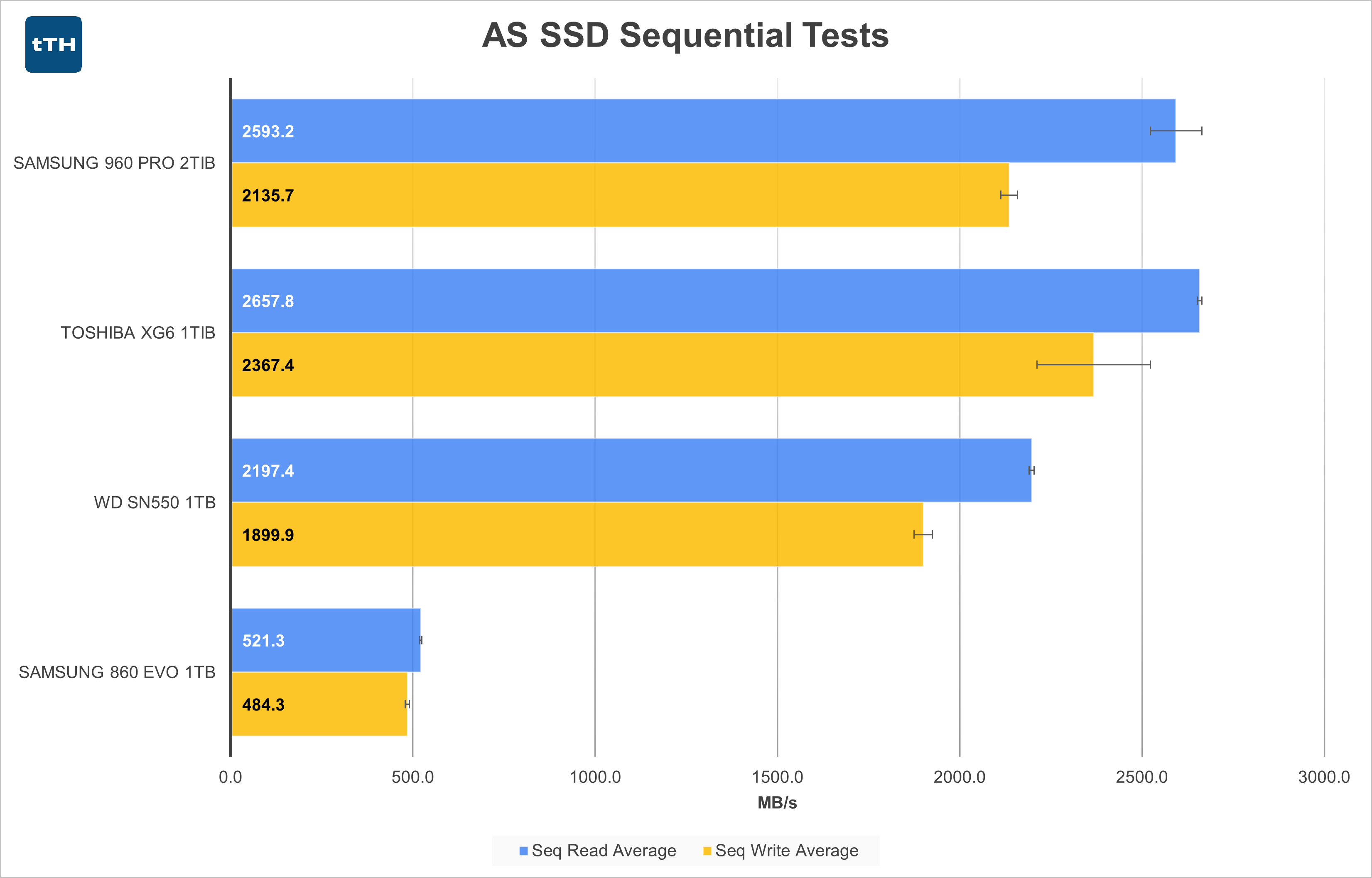 For 1GB sequential reads and writes, the 960 Pro is roughly on-par with the XG6, which isn’t a bad thing. Notably, the XG6 delivers higher write speeds for smaller sequential writes like this test due to having higher peak write speeds to its SLC cache, though the lead over the 960 Pro isn’t very large.
For 1GB sequential reads and writes, the 960 Pro is roughly on-par with the XG6, which isn’t a bad thing. Notably, the XG6 delivers higher write speeds for smaller sequential writes like this test due to having higher peak write speeds to its SLC cache, though the lead over the 960 Pro isn’t very large.
The 960 Pro outperforms the SN550 by around 18% for reads and 12% for writes. SATA drives are in a completely different (lower) league compared to these high performance NVMe drives.
AS-SSD 4K Tests
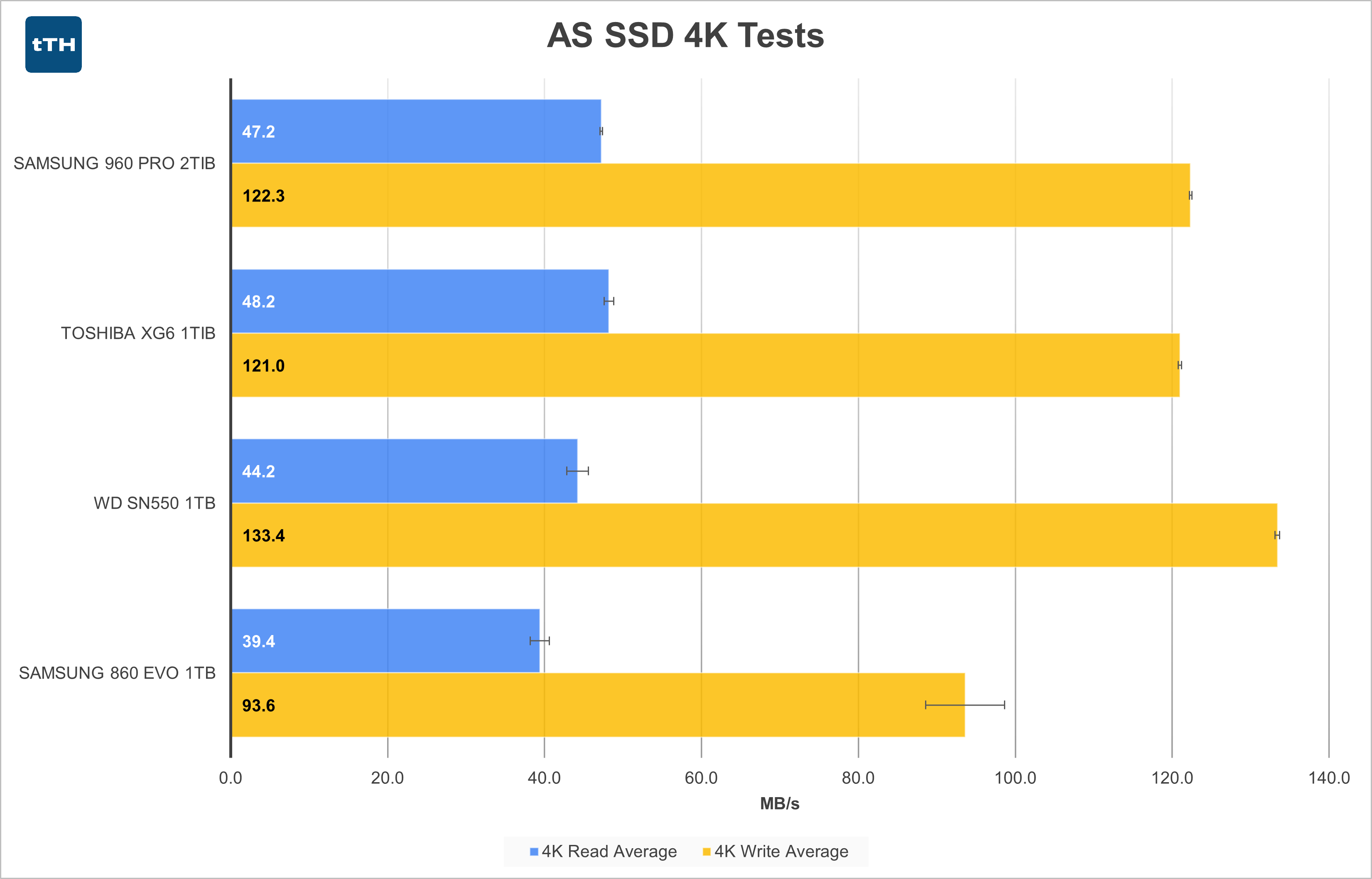 Similar to the AS SSD Sequential test above, the 960 Pro’s performance is very similar to that of the XG6. Here, there isn’t much separation between the drives, even the SATA 860 EVO, though DRAMless, QLC, and otherwise low-end NVMe and SATA drives will suffer somewhat in this test as will older SSDs.
Similar to the AS SSD Sequential test above, the 960 Pro’s performance is very similar to that of the XG6. Here, there isn’t much separation between the drives, even the SATA 860 EVO, though DRAMless, QLC, and otherwise low-end NVMe and SATA drives will suffer somewhat in this test as will older SSDs.
PCMark 8 Storage Test
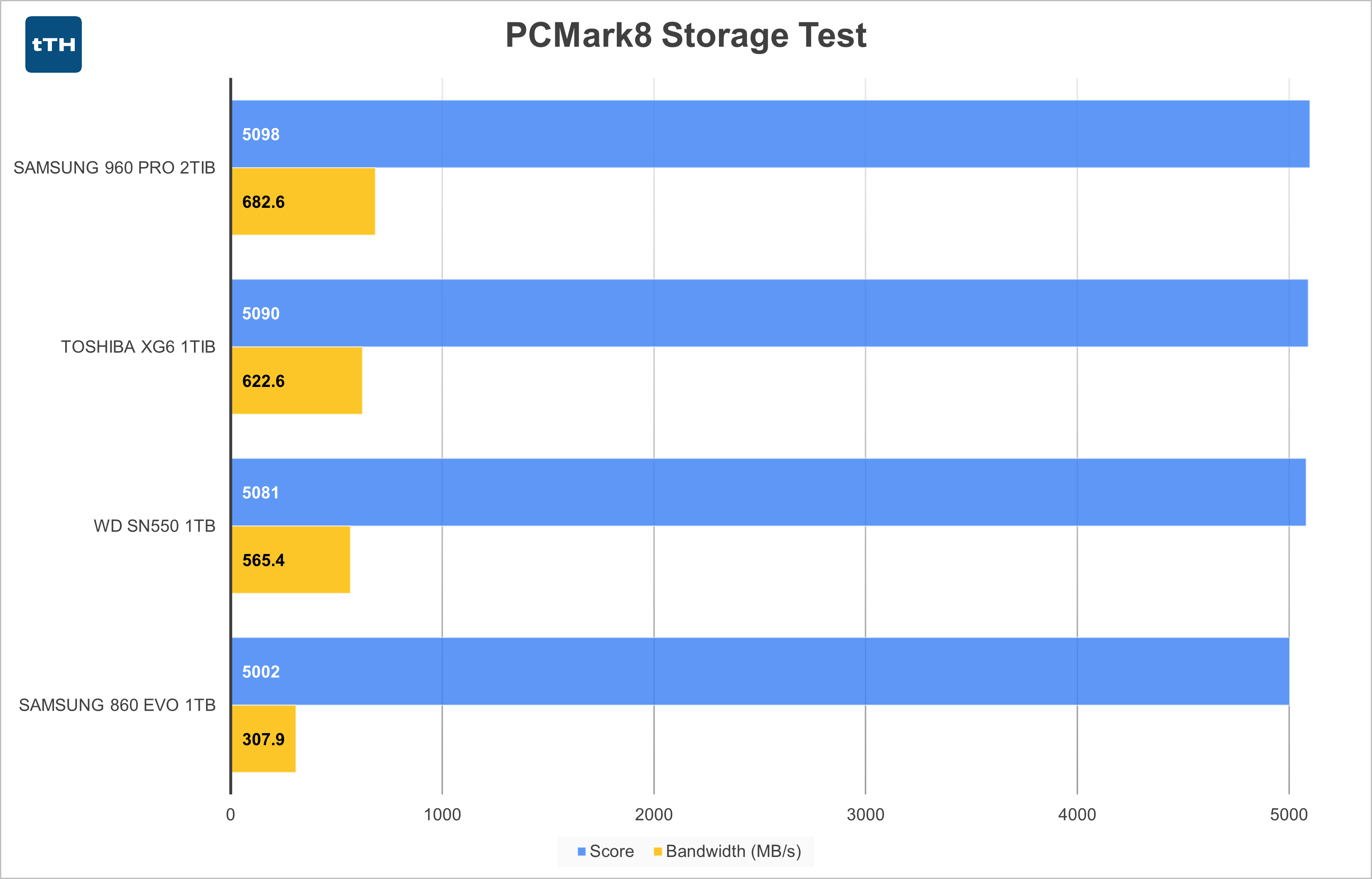 As with most of the other tests thus far, in the PCMark 8 Storage Test the 960 Pro mostly matches the newer XG6. Despite delivering about 20% higher performance than the SN550, you’d likely be hard-pressed to tell the difference between those two drives head-to-head in most consumer workloads as the differences in measured times for the various sub-tests are mostly fractions of a second.
As with most of the other tests thus far, in the PCMark 8 Storage Test the 960 Pro mostly matches the newer XG6. Despite delivering about 20% higher performance than the SN550, you’d likely be hard-pressed to tell the difference between those two drives head-to-head in most consumer workloads as the differences in measured times for the various sub-tests are mostly fractions of a second.
Large-File Transfer Tests
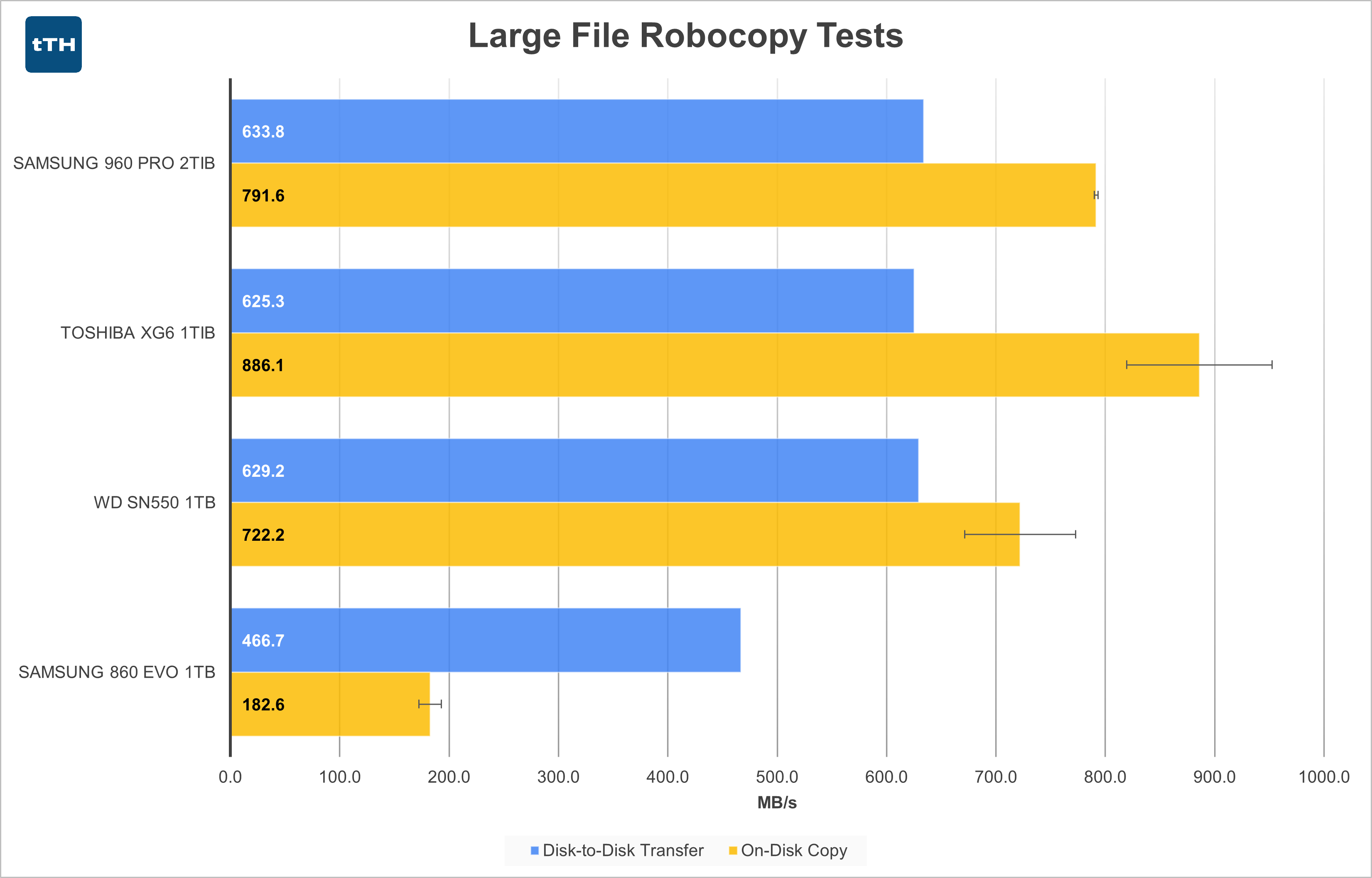 In case the disk-to-disk transfer, if numbers look a bit odd for the faster NVMe drives, recall that this test is a mostly sequential 30GB transfer from a read-source that peaks at 750MB/s. Unlike the 128GB drives that mostly don’t even peak at (let alone sustain) over 750MB/s, the faster drives are severely bottlenecked during the copy portion of this test as they can write at significantly greater than 750MB/s. This testing bottleneck will be remedied on my next-generation testbed.
In case the disk-to-disk transfer, if numbers look a bit odd for the faster NVMe drives, recall that this test is a mostly sequential 30GB transfer from a read-source that peaks at 750MB/s. Unlike the 128GB drives that mostly don’t even peak at (let alone sustain) over 750MB/s, the faster drives are severely bottlenecked during the copy portion of this test as they can write at significantly greater than 750MB/s. This testing bottleneck will be remedied on my next-generation testbed.
With that disclaimer out of the way, we see the 960 Pro running up against the same ~630MB/s barrier that the other high performing NVMe drives hit on this test rig. As expected for a high-performance NVMe drive, on-disk copy operations for large files are faster on the 960 Pro on this testbed. What’s interesting here is that the 960 Pro underperforms the XG6 by a healthy 11% margin. This characteristic is what lead me to develop my large-file copy test and was the reason why I felt the 960 Pro underperformed my expectations in my own personal use of the drive.
Regardless of the disappointments of my past self, the 960 Pro and the other NVMe drives in this roundup deliver several times the on-disk copy performance of the best SATA drives.
Small-File Transfer Tests
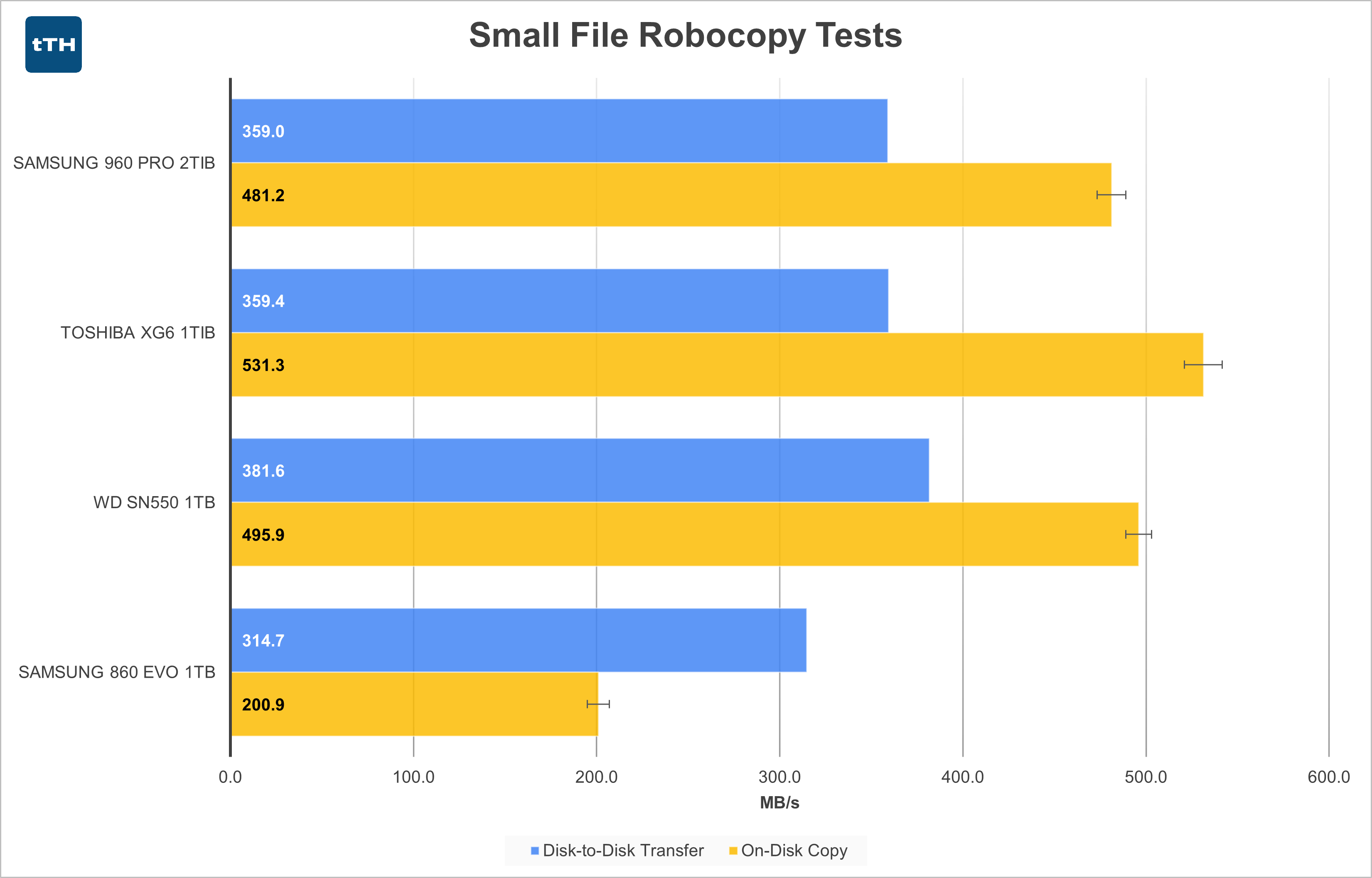 For the small-file tests the results are more of the same. Disk-to-disk performance of all three NVMe drives is similar, again somewhat capped by the bottlenecked source drive. On-disk copies actually place the 960 Pro last of the three NVMe drives in this test by a small margin, though in this metric the reason behind this loss has shifted to the other drives peak SLC write speeds – since this test is small enough to mostly or completely fit within their fast SLC caches.
For the small-file tests the results are more of the same. Disk-to-disk performance of all three NVMe drives is similar, again somewhat capped by the bottlenecked source drive. On-disk copies actually place the 960 Pro last of the three NVMe drives in this test by a small margin, though in this metric the reason behind this loss has shifted to the other drives peak SLC write speeds – since this test is small enough to mostly or completely fit within their fast SLC caches.
Conclusion
What this review is really intended to do is provide a set of datapoints for how an older high-end drive performed and to help me better characterize the performance of a drive I spent many hours (sometimes impatiently) using.
Of the SSDs I had on-hand when I began testing drives, the Samsung 960 Pro was the one I was most excited to test due to its high-end nature and my personal experience with the drive. The drive is nowhere near cutting edge at the time of this writing. It is one of the older NVMe drive models I’ve tested, if not the oldest. Although it did tend to perform better than the newer but more down-market models, I somehow expected more from the former flagship. I guess this is just a case where reality didn’t meet my expectations.
That’s not to say that the 960 Pro is lackluster. Particularly when it launched it was well ahead of its competition. It’s just that in the intervening 4 years the competition has caught up – at least to the high bar the 960 Pro set when it was released. Unfortunately I don’t have any of its contemporaries to compare it to – at least partly because most of those were pretty mediocre next to the 960 Pro, didn’t offer the 2TB capacity which I needed at the time, and (at least based on my analysis at the time) weren’t worth the price premium over competing SATA SSDs.
Today, high capacity drives remain somewhat rare and premium. There are certainly more drive models that match or exceed the 2TiB/2TB capacity, but there are still plenty of models that top out at a more consumer-friendly 1TB. Thankfully the price premium for 2TB/2TiB drives is certainly lower than the shocking $1300 the 2TiB 960 Pro originally sold for, though a lot of this is just the steady decrease in NAND prices over time. NAND density improvements over the years have shifted the peak capacity options for consumer SSDs to 4TB or 8TB.
One area where more modern drives may start to trail the 960 Pro is in write endurance. In theory the TLC-based 970 EVO Plus 2TB matches the 1200TBW rating of the 960 Pro, but in practice the endurance of MLC should far exceed even the best TLC. That said, 1200TBW is a LOT of writes for a consumer machine (as opposed to a server that faces 24/7 load). Even my 960 Pro which I used pretty heavily for several years for virtualization work only has about 50TB of writes on it – a mere 4% of its rated endurance. In most cases, most drives will have far more endurance than the average consumer will ever need. The drive will either be outdated or fail for other reasons before the NAND endurance is exhausted. The up and coming exception to this notion is QLC drives, though at least in larger capacities endurance still shouldn’t be as big of a worry as many enthusiasts make it out to be.
But none of this is buying advice. In 2021, the 960 Pro is probably a silly SSD to buy. Even compared to a used 960 Pro there are less expensive drives in the 2TB-size-class. Unless you’re getting an extremely good deal on a drive you know hasn’t had its NAND exhausted by having lived its life inside a write-heavy server there are going to be better options available.
Nostalgia and curiosity were the main driving forces behind me writing this review, and now both feelings have been satiated. At least, unlike so many things in the computer industry, the 960 Pro seems to have aged with grace.